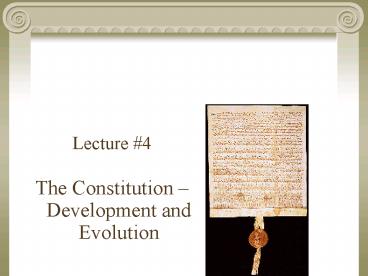The Constitution Development and Evolution - PowerPoint PPT Presentation
1 / 11
Title:
The Constitution Development and Evolution
Description:
Judiciary Chosen by the Legislature. The New Jersey Plan ... A Two Chambered Legislature with Equal Representation for states in the Senate ... – PowerPoint PPT presentation
Number of Views:20
Avg rating:3.0/5.0
Title: The Constitution Development and Evolution
1
- Lecture 4
- The Constitution Development and Evolution
2
Influences of the Colonial Experience
- Articles of Confederation
- Problems under the Articles
- Money - No ability to raise revenue, coin money
- Trade
- Primary loyalty to states
- Quorum was rare
- Shays Rebellion
- The Constitutional Convention
3
Constitutions, Institutions, and Governments
- The Constitution of a nation creates its
governing institutions and the set of rules
prescribing the political process these
institutions must follow to reach and enforce
collective agreements - Institutions consist of roles that are designed
and linked together with rules to perform some
intended purpose. In government, roles are often
formalized as offices positions that confer on
their occupants specific authority and
responsibilities - A government consists of those institutions
created by the constitution and charged with
making and enforcing collective agreements. - Authority is the acknowledged right of the office
to make a particular decision for all participants
4
- A constitution is a nations basic law. It
creates political institutions, it allocates
power within government, and it provides
guarantees to citizens. A constitution sets the
broad rules of the game of politics it allows
certain types of competition among certain
players. - Point!
- These rules are never neutral
5
Constitutional Convention Controversies
Representation
- The Virginia Plan
- Representation Allocated on the Basis of
Population Power Drawn from the People and Not
the Member States - A Powerful Central Government with Three Branches
- Two Chambered Legislature
- Executive Chosen by the Legislature
- Judiciary Chosen by the Legislature
- The New Jersey Plan
- A Strengthening of the Articles of Confederation
- A One Chambered Legislature
- A Majority for Decisions (rather than a
super-majority) - The Power to Tax
6
Controversies Representation
- The Great Compromise
- A Two Chambered Legislature with Equal
Representation for states in the Senate and
representation based on population in the House - Either chamber may introduce legislation and both
chambers must agree for it to pass
- The Three-Fifths Compromise
- (otherwise known as the not-so-great compromise)
- Slaves counted as three-fifths for purposes of
allocation of representation
7
Controversy Representation
- The Presidency
- The Electoral College as compromise between the
large and small states - Does not provide for direct election of the
president by the people
8
Constitutional Convention Principles
- Separation of Powers
- A balanced government avoids a concentration of
power - Checks and Balances
- Examples
- The presidents signature
- Judicial review
- Presidential veto
- Veto override
- Confirmation of nominees and ratification of
treaties
- The powers of government should be so divided
and balanced among several bodies of magistracy,
as that no one could transcend their legal
limits, without being effectually checked and
constrained by the others. Thomas Jefferson
Notes on the State of Virginia
9
Constitutional Convention Principles
- Federalism
- Supremacy Clause (Article VI)
- Laws . . . Under the Authority of the United
States shall be the supreme Law of the Land - Powers reserved for the national government
- Elastic Clause (Article I)
- . . . All laws that are necessary and proper
to carry out its responsibilities
10
Constitutional Convention Principles
- Republican
- Democracies have ever been spectacles of
turbulence and contention have ever been found
incompatible with personal security or the rights
of property and have in general been as short in
their lives as they have been violent in their
deaths. James Madison, Federalist, No. 10 - Representative government filters majority
sentiment and protects the rights of minorities.
This in turn protects the rights of the
individual. - Limited Government
- The Constitution identifies both what the
government can do and what it cannot do. Both
features limit government.
11
Constitutional Convention Principles
- Majority Rule/Minority Rights
- Did this through 1) divided authority 2) formal
boundaries on what the government may do 3)
electoral rules - Indirect Elections Senate, President, Judges
- Established Dates for Elections/Fixed Terms in
Office - Geographically Defined Representation































